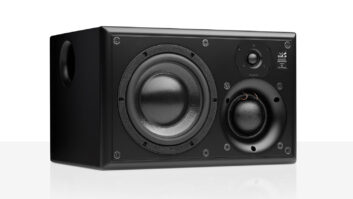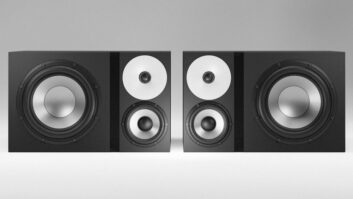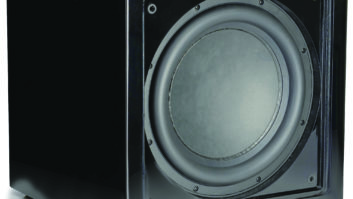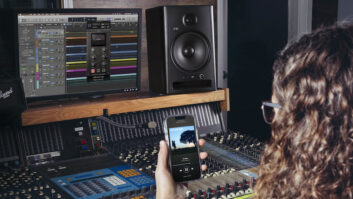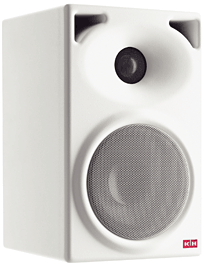
Klein + Hummel’s 0 110 D active monitors are a next-generation digital successor to the company’s 0 110 analog model. The new monitors sport analog inputs and AES/EBU and S/PDIF inputs with 24-bit digital conversion (32 to 96 kHz). The 5.5-inch woofer and 1-inch, titanium fabric-dome tweeter are bi-amped and magnetically shielded, and each are driven by their own 50-watt power amps, with a crossover point at 2.5 kHz with 24dB per octave slope. Frequency response is rated at approximately 58 to 20k Hz.
The 0 110 Ds are available in a variety of colors (enamel anthracite gray, white or custom colors) and have a deceptively small footprint (170×267×190 mm), but still pack a punch, even when used on a workstation desktop or in a video production suite.
PICK YOUR FORMAT
The unit has a built-in, dual-purpose, switchable XLR input jack for analog or digital operation, so getting signal into the 0 110 Ds comes down to whatever you require. Input sensitivity on the analog side is +6 dBu (1.55V), and an input attenuator trim pot allows for continuous control from 0 to 24 dB in both analog and digital modes.
The XLR and BNC connectors are wired in parallel across a transformer, which allows external termination and a variety of stereo connection schemes, including AES/EBU via one BNC cable, AES/EBU via two XLR cables, S/PDIF (or AES-3id) with two T-connectors and so on.
For equalization, a pair of four-position rotary switches allow you to adjust bass and midrange frequencies to compensate for room response. Silk-screened setup suggestions let you quickly dial in your preferences. Bass settings are optimized for speaker placements that include freestanding, near a wall, flat against the wall and corner settings; the midrange settings are optimized for freestanding, tabletop, meter bridge or soffit-type situations.
OUT AND ABOUT
My tests with the 0 110 Ds were varied and, at times, punishing. First, I took them out on location for an off-Broadway vocal recording session with male and female soloists and piano accompaniment. I was immediately taken with the monitors’ larger-than-expected sound, as well as their wide and useful sweet spot.
Working in a small room just off the concert hall, the composer/arranger and I had a clear idea of where we were going with the vocal levels and placement, which I won’t usually attempt on location. The redesigned waveguide and drivers did a stand-up job of widening the sweet spot and translating well, no matter where I had them.
In use as field/remote speakers, I had little time to agonize over their placement. I just set them up and went for it, hoping for the best. The 0 110 Ds’ stereo imaging was always clear and detailed, and there were no nasty surprises when I checked the mixes back in the studio.
I didn’t need to play with the EQ settings very much. However, in most of my sessions, the monitors were far enough away from any walls or corners, usually in a free field, up on pedestals for a direct line of sight (and listening position) on the remotes. Because of this, I noticed that the compensation trim pots have enough range to handle excessive bass buildup or harsh, bright surfaces.
Another test involved tracking a variety of string players in small clusters for a videogame soundtrack. While the session itself was tricky, the monitors’ playback was robust and detailed, accurately reproducing lots of low-end synths and drums, which allowed the composer to hear the full-range music bed we were synching to in the session. The 0 110 Ds were just what we needed, keeping the composer happy each time he returned to the playback booth for reality checks and decision-making.
THE D, PLEASE
The 0 110 Ds offer a lot of features and pack a lot of punch for their size. Their sound is smooth, wide and open. I found their portability and twin inputs to be very handy. I used them as monitors for video and audio sweetening, as rear surround speakers in the studio and on the road whenever I had a soundtrack or tracking session. On the aesthetic side, the white-colored versions blended in with the new iMac in my studio. This very flexible, attractive package may be just what you’re looking for in a great-sounding, portable active monitor. Prices: gray, $1,495 each; all other colors, $1,795 each.
Klein + Hummel, dist. by Sennheiser, 860/434-9190, www.klein-hummel.com, www.sennheiserusa.com.
Joe Hannigan runs Weston Sound & Video in Delaware.
